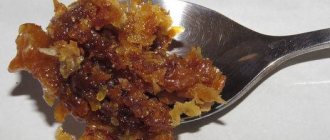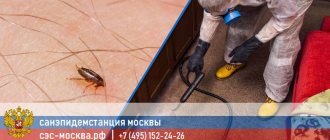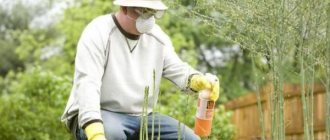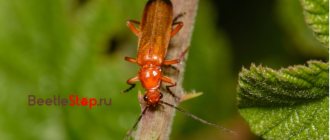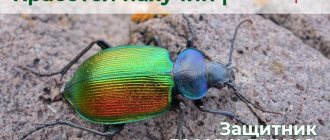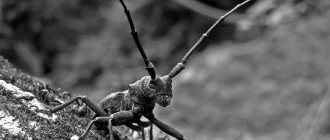Waxworts belong to the lamellar family. Small beetles are distinguished by a large number of hairs on their body and variegated elytra. A common color option is yellow with black bands. In summer, a beetle similar to a bumblebee can be seen on rosehip flowers. This is a bandaged waxwing, its chest and abdomen are abundantly covered with thick reddish hairs. Beetles fly all summer. They are found in deciduous forests and in the mountains in the south. The larvae are completely different from their parents. The worm-like offspring live secretly in rotten stumps.
Appearance of waxweed
The body length of the waxweed varies from 9 to 16 millimeters. The body is slightly shiny, while the elytra are matte, but with shiny tubercles. The body is black, and the elytra are light yellow or reddish yellow. The elytra have 3 transverse bands and a narrow border along the edge. But the pattern of the elytra may change.
Banded waxweed (Trichius fasciatus).
The head is small, covered with long yellow hairs. The prospit is convex, it is covered with long and dense hairs of yellow, reddish-yellow or gray-yellow color. The body protrudes slightly from under the elytra. The lower part of the body is also covered with yellow hairs, but they are denser on the chest than on the abdomen. The legs are densely covered with dotted lines.
The pattern of the elytra can vary significantly: be practically invisible or, on the contrary, occupy most of the elytra.
Color Variation
The pattern of the elytra changes significantly in insects living in different areas. The ratio of yellow and black varies in different variations. This variability is called aberration. It occurs accidentally under the influence of temperature and other factors acting on the larval stage. There are individuals with a short anterior and middle band, and beetles with a predominance of black or yellow color. In aberration dubius the bands are reduced to dark spots on the shoulders. The obliquus group of insects is distinguished by an oblique median band extending from the shoulder to the suture at the apex of the elytra.
Description
The genus includes relatively small beetles, 10–16 mm long. Representatives of the genus have a wide, rather slightly convex body on top, covered with abundant and long, light hairs. Many species are black in color, usually with yellow elytra bearing 3 black transverse bands (one at the base, one in the middle and one at the apex), often more or less reduced or highly developed and more or less completely replacing the yellow color. Among the East Asian species there are other shades of color: the main background can be green or brown-red, with small spots of white or yellow scattered over it.
The pronotum is much narrower than the base of the elytra, with more or less rounded lateral margins. The top is covered with dots and hairs, which in some species are very thick and long. The scutellum in most species is small, rather short, semicircular. The elytra are wide, slightly convex, in thin grooves, with intervals, covered with dots and light hairs. The legs are long and slender.
Reproduction
The beetles lay their eggs in rotten wood and stumps, where the larvae develop. Their accumulations were found in such tree species as birch and aspen.
The larva is distinguished by a not particularly thick, C-shaped curved body. The head is matte, finely wrinkled, brownish-yellow, and is widest in the middle, at the base of each antennae with a round, black eye. The antennae are quite thick, the length of their segments is only slightly greater than their thickness. The legs are rather short and bear small, curved, sharp claws. The body length of the 3rd instar larva is up to 40 mm, the head length is 3.2 mm, the head width is 4 mm.
Pupation occurs in the wood where the larva lived in the spring, after a single overwintering, that is, the beetles have an annual generation.
Reproduction of waxweeds
Females lay eggs in rotting wood. Larvae most often develop in aspen and birch. The larvae have a body that is not too thick, C-shaped. The head is brown-yellow, matte. The upper jaws are wide and strong. The limbs of the larva are short. Three-year-old larvae reach about 40 millimeters in length.
Flower nectar is a favorite delicacy of waxworts.
The larvae pupate in the spring, in the same wood. Waxworts have a one-year generation, but in the Far North development takes 2 years.
If you find an error, please select a piece of text and press Ctrl+Enter.
Area
The distribution is very wide, the range covers the territory from the Atlantic to the Pacific Ocean and from the Arctic. Within the countries of the former USSR, the northern border in the western part of the range runs near the Arctic Circle, sometimes crossing it. Starting from the Kola Peninsula it goes further along the shores of the White Sea, including the Solovetsky Islands, along the Lower Tunguska, the Vilyui River, to the lower reaches of Aldan and further east to the Sea of Okhotsk. Isolatedly distributed in the forest part of Kamchatka and on the islands of Sakhalin, Shantar and Kuril Islands. The southern border goes through the Chernivtsi and Vinnitsa regions, Zhitomir, north of Kiev, Chernigov and Sumy regions, Kharkov (Lozovenki), Voronezh, Saratov, Uralsk, Orsk, along the steppes of Northern Kazakhstan to the Zaisan depression, from where there is a branch to the south - to the Dzungarian Alatau, along the Tien Shan mountain system. Further east, the southern border runs along the northern part of Xinjiang and the mountainous regions of Mongolia, in Northeast China. Also found in Japan.
Distributed in Europe, where it is found as far as northern Norway and England, and south to Portugal, Spain, Italy, Albania, Macedonia, Bulgaria. The Caucasian range of the species is isolated from the main range, where it is mainly associated with mountains.
Distribution area
The striped waxweed is distributed throughout the Palearctic. The northern border of its habitat runs through the Arctic, in the south – along the Caucasus and Tien Shan mountains. Beetles are found throughout Europe: Norway, Great Britain, Portugal, Spain, Bulgaria, and the Baltic countries. In the east he lives in Mongolia, northern China, and Japan. In Russia, the common waxweed lives on the shores of the Sea of Okhotsk and the White Sea, in the central regions. There is an isolated population of insects on the Kuril Islands, Kamchatka and Sakhalin. In the Caucasus mountains, beetles live at an altitude of 2000 m, and in the Tien Shan they rise to 1600 m.
Information. The species bandaged waxweed is listed in the Red Book of Moscow. Beetles are common in the region, but in the capital their population is declining. Negative factors: mowing forbs to create lawns, hunting beetles for their decorative value. The reduction in the number of insects is facilitated by the destruction of dead wood in parks, which is a place for the development of larvae.
Description
Body length 9-16 mm. The body is wide, slightly convex above. The body is slightly shiny, the elytra are matte, mostly with shiny tubercles. The color is black, the elytra are light yellow (sometimes reddish-yellow), with a black pattern represented by a narrow border along the lateral edge and seam and 3 transverse bands - at the base, in the middle and at the bottom of the elytra. The middle band is somewhat interrupted in the middle. The pattern of the elytra is extremely variable.
The head is small, covered with dots and thick, long yellow hairs. The pronotum is moderately convex, has the greatest width in the middle, weakly behind, slightly more narrowed in front. Covered with very thick, long, yellow or reddish-yellow or gray-yellow hairs. The anterior and posterior margins of the pronotum are bordered, the anterior angles are obtuse, the lateral margins are rounded, the posterior angles are obtuse and rounded. The abdomen protrudes slightly from under the elytra. The lower part of the body is covered with dense, long yellow hairs; on the abdomen there are only slightly sparse hairs than on the chest. Legs with dense, coarse punctures.
Variability
File:Trichius fasciatus Linné, 1758 (3185392536).jpg
The pattern of the elytra is extremely variable. The black color can be reduced or, conversely, occupy the predominant part of the elytra. At ab. obliquus
the middle band runs in the form of an oblique strip and extends from the humeral tubercle to the suture angle at the apex of the elytra.
Ab.
pulchellus is distinguished by a shortened anterior and greatly shortened middle band.
At ab.
dubius is predominantly yellow in color, and the black bands are small, the anterior one is reduced and is expressed only in the form of a shoulder patch.
Ab.
commutatus differs from the previous one in that the front black band is connected to the middle stripe on the lateral edge.
At ab.
fennicus, the anterior yellow band is very wide and continues along the suture in the form of a tapering strip.
Description of the species
Banded waxweed (Trichiusfasciatus) or striped waxweed (common) is a representative of the family of lamellar cerebellums, the genus of waxworts. The body length of the beetle is 9-15 mm, the shape is wide. The main color is black. The head is small, directed forward. The antennae are 10-segmented with a characteristic 3-segmented lamellar club opening in the form of a fan. The eyes are faceted, large and protruding. The head is covered with dots and long yellow hairs.
The pronotum is narrower than the elytra, its widest part is in the middle. The anterior margin is strongly narrowed. The sides are rounded, the front and rear corners are obtuse. The pronotum is completely pubescent. The hairs of insects are colored reddish-yellow or gray. The elytra are matte, slightly convex, with several shiny tubercles and longitudinal grooves. The main background is light yellow, with a pattern of black stripes along the side edge and seam. The elytra are shorter in length than the abdomen, part of it remains uncovered. On the surface of the elytra there are three transverse bands, running sequentially from the base to the posterior margin. Medium intermittent.
Light transparent wings are well developed. Beetles fly in search of food and escape from danger. The abdomen is black, segmented. The rear end, protruding from under the elytra, is covered with long red hairs. The legs are long, slender, covered with dense, coarse punctures. There are two teeth on the outside of the front legs, and a spine-like outgrowth on the hind legs. The paws end in sharp claws.
Interesting fact. The English name of the species Beebeetle means "beetle like a bee." The reason for the nickname was the thick pubescence and yellow-black coloring of the insects.
Lifestyle
Common waxweed is a summer species. The beetles appear in May-June and fly all summer until September. In the subtropical zone (Transcaucasia), adults reach the surface already in April. Habitats: heated edges of broad-leaved and mixed forests, clearings and meadows overgrown with tall grass and shrubs. Insects are often found in gardens and vegetable gardens. They feed on carrots, parsley, and dill. Beetles are not pests, but beneficial insects. A lot of pollen clings to the numerous hairs of the striped waxweed, flying between flowers, they contribute to cross-pollination.
Insects are active during the daytime and hide under trees during rain. Most of the time, adults sit on flowering herbaceous plants, burying their heads in the inflorescence. They feed on pollen and nectar, preferring umbelliferous plants (hemlock, hogweed, angelica), rose hips, and elderberries.
Reproduction and development of offspring
The breeding season occurs in early June. Fertilized females lay 20-40 oval eggs under the bark, in hollows and cracks of deciduous trees. The larvae live in rotten wood, stumps and large dead wood. Most often they are found in the outer part of dry, rotten trunks and branches lying on the ground. The favorite species of larvae are aspen, birch, alder, and oak. At birth they are no more than 5 mm, by the end of development they reach 40 mm.
The body structure is typical for the lamellar family - C-shaped, cylindrical, not very thick. The color is off-white. The head is small, matte, brown-yellow. The upper jaws are wide and well developed. There are simple eyes. The antennae are 4-segmented. It moves with the help of three pairs of short legs. The larva goes through 3 instars. In temperate and warm climates, one generation develops per year. The larvae overwinter in wood and pupate in a cradle in the spring. Doll, soft, free. In the far north, the offspring do not have time to form during the short warm season; development is delayed for two years.
Text of the book “Beetles. World of amazing insects"
Mikhail Kutsenko Beetles World of amazing insects Visual pocket guide
Illustrations and photographs were used in the design: 5W Studio, ANVpics, Victor Z, AVIcon, Achkin, alslutsky, Anest, anitasstudio, Anton Kozyrev, Arno van Dulmen, blackboard1965, Chelnokov Vladimir, Cosmin Manci, D. Kucharski K. Kucharska, Digital Photo, Ed Phillips, Emilio100, Eric Isselee, Gideon Ikigai, Grezova Olga, gstalker, Henrik Larsson, Ilizia, irin-k, Jurik Peter, Juris Kraulis, Khumthong, Marco Uliana, mykhailo pavlenko, N-sky, skydie, Tomasz Klejdysz, Tsekhmister, TYNZA, Viktoriia Janis, Vitalii Hulai / Shutterstock.com
Used under license from Shutterstock.com
Files: https://cloud.eksmo.ru/s/g2ynqRQmDiefzyP
Series “Nature in your pocket”
© Kutsenko M., text 2020
© Design. Eksmo Publishing House LLC, 2020
* * *
Introduction
Beetles are the largest and most diverse order of insects in terms of species, scientifically called Coleoptera. To date, about 350 thousand described species are known. This is almost 40% of all insects living on the planet. What is most surprising is that every year their number increases significantly, and more and more new species are discovered. More than 13,500 species of Coleoptera live in Russia. According to the forecasts of biologists, the actual number of beetles on the planet is more than 5 million species. It’s safe to say that every third insect on our planet is a beetle.
The variety of sizes and shapes of beetles is amazing. There are insects that are long and thin, short and thick, and some that are completely inconspicuous. Often the beetle's name is descriptive. Different types of beetles are similar to each other in external structure. They have three components - head, chest and abdomen, covered with a hard shell. Antennae help beetles navigate in space. There are about ten sensitive zones on the antennae.
The life cycle of beetles is a complete metamorphosis. This means that they have four completely different stages of development. Adult female beetles lay eggs. The eggs hatch into a larval stage, usually wingless. The larva feeds and grows. As a result, she turns into a pupa that does not move or feed. The next, final stage is the transformation of the pupa into an adult beetle. Some species prefer to care for their offspring. Basically, this process does not interest them.
Most beetles perform a sanitary function, since many of them feed on the waste products of other animals or plants. For example, beetles eat fallen tree leaves and animal digestion products. By doing so, they restore the balance of chemicals in nature, such as CO2 and N, preventing them from excessively accumulating in the atmosphere and soil. Some types of beetles “specialize” in the disposal of dead small animals or rotting plants.
Beetles are distributed throughout the planet, except in the polar regions. They consume absolutely all types of food. Most of these insects feed on plants, leaves or seeds, fruits or wood. Numerous species - predators - destroy other insects and small animals. Some people eat mushrooms. There are many species that feed on dung. Often, larvae and adult insects eat different foods. In turn, most of these insects and their larvae serve as food for birds, fish and various insectivorous mammals. Many of the representatives of this order are synanthropes, that is, their way of life is associated with humans and their housing. They are either direct pests or a means of human control of such pests.
Camouflage is an excellent form of protection for beetles. It is especially widespread among families that feed on wood or vegetation. Another form of species survival is chemical protection. As a rule, its owners have bright or contrasting colors, thereby warning predators.
The branch of science that studies beetles is called coleopterology. Let's try to feel like coleopterologists and, with the help of this book, understand the most famous species of this endless order of insects.
Accepted notations
– classification;
– a brief description of the appearance;
- habitat;
– developmental features;
– food preferences.
1 Crimson Fireflower (Blood Rubella, Scarlet Fireflower) Pyrochroa coccinea
– Order Coleoptera, family Fireflower, genus Fireflower, species of crimson fireflower.
– The body of the insect is quite large, flat, 14–15 mm long. The main color is black, the elytra are blood-red.
– Favorite habitats: forests and groves with a significant presence of birch. The beetles are found from May to June on flowers, foliage and fallen trees.
- Rare view. Little studied. Development lasts 2–3 years.
– Adults are vegetarians, feeding on nectar, carrion and tree sap. The larvae are predators, develop and live under the bark of trees. There they get themselves the larvae of various invertebrates and bark beetles.
2 Birch sapwood Scolytus ratzeburgi
– Order Coleoptera, family of weevils, genus of sapwood, species birch sapwood.
– A small beetle 4.5–6.5 mm long. Color black, shiny. The elytra are shiny and smooth, with sparse hairs at the apex. The abdomen is concave.
– Distributed in forests with a large content of birch trees. The beetles' flight is observed in May.
– Females lay eggs in June. After 10–14 days, the larvae appear. Young beetles emerge in May. The insect has an annual development cycle.
– Adults gnaw the bark near the buds and bast. The larvae feed on bark and wood.
3 Greater pine borer (greater copperhead borer) Chalcophora mariana
– Order Coleoptera, family borer, genus Chalcophora, species large pine borer.
– Quite a large beetle, 21–32 mm long. The color of the borer is dark bronze, with a copper or copper-green sheen. The pronotum is often paler, greenish or violet-tinged. A characteristic feature of these beetles are four longitudinal carinae on the upper back.
– Found in pine and mixed forests on trees and shrubs. Beetles are most active in early summer.
– Females lay eggs in cracks in pine bark. Two weeks later, the hatched larvae bore into the bark. The duration of development is 3–6 years.
– Adults feed on bark, petioles and leaves. The larvae feed on dry trunks, but most prefer living wood, which can sometimes pose a serious danger to coniferous forests.
4 Large flour beetle (flour beetle, tormentor) Tenebrio molitor
– Order Coleoptera, family of darkling beetles, genus Tenebrio, species of large mealworm.
– Beetles reach 12–18 mm in length. The body is elongated, flattened. It is black-brown above, with a dull, greasy sheen, and reddish below. The beetle flies well.
– The main habitat is in the area of food industry enterprises. They settle in the territories of mills, feed mills, poultry farms, food warehouses and granaries.
– At the end of summer, the female lays 150 to 200 eggs on food. Soon larvae emerge from them. Their development continues for about a year. The beetles appear in July and August, are active in the evening and at night, and readily fly towards fire.
– Both adults and larvae feed on a wide variety of foods of both plant and animal origin. However, they prefer flour and bran, especially raw and musty ones. The larvae can go without food for up to 8 months. The main harm of the insect consists not only in the destruction of part of the products, but mainly in their contamination with excrement.
5 Bombardier crackling (crackling bombardier) Brachinus crepitans
– Order Coleoptera, family of ground beetles, genus of bombardier beetles, species bombardier.
– The length of the body of the bombardier is 6.3–10.2 mm. It is colored red-red, the elytra are blue-black, often with a greenish tint. The head, antennae and paws are yellow-red.
– Insects prefer to settle in dry, sunny areas. They are attracted to soil with a high limestone content. Adults live under stones and logs. Usually form small groups.
– Beetles appear in May and early June. The life cycle is poorly studied. The full development cycle takes 24 days. When in danger, the beetle secretes a toxic liquid with temperatures up to 100 °C.
– Bombardier beetles feed on earthworms and insect larvae. The larva, developing in the soil, parasitizes the pupae of other beetles.
6 Hairy bronze fawn (hairy fawn, hairy deer) Tropinota hirta
– Order Coleoptera, family Lamelidae, genus Epicometis, species hairy bronze.
– Matte black beetle 9–11 mm long. There are 12 transverse white spots of varying sizes on the wings. The entire body of the insect is covered with thick yellowish-gray hairs.
– Bronzovka is common in the steppe and forest-steppe zones, and is especially common in gardens and fields.
– Each female lays 15–20 eggs in dung heaps or under rotted leaves. Soon the larvae appear. By autumn, the period of adult beetles begins. They remain overwintering in the soil.
– Beetles feed on the flowers of various herbaceous and woody plants. They cause significant damage to gardens and berry fields. The larvae prefer humus and decaying plant debris. At the same time, they do not damage the roots.
7 Gyrinus natator
– Order Coleoptera, family of spinners, genus of spinners, species of spinner-floater.
– Shiny blue-black, oval beetle measuring 4.8–5.5 mm.
– Insects prefer quiet, fresh water bodies with standing water. They are also attracted to slow-flowing rivers. They spend most of their time circling on the surface of the water. They usually live in flocks.
– In spring, the female lays eggs in cords or in groups on aquatic plants. After a few weeks, slender larvae appear, the entire period of development of which passes under water. In August–September, a mass appearance of young insects is observed.
– The adult floater feeds on mosquitoes and other types of insects, as well as their larvae, which it catches both on the surface of the water and under water. The larvae of whirligigs are predators that hunt small prey.
8 Ham beetle Dermestes lardarius
– Order of Coleoptera, family of leather beetles, genus of leather beetles, species of ham leather beetle.
– A small oval bug 7–9 mm long. The insect is black in color, with transverse grayish-brown stripes on the front of the elytra. There are 6 black dots on the strip.
– Found everywhere. Prefers living quarters, basements, attics.
– The female lays 5-6 eggs per day for 2 months. After 7–8 days, the larvae appear. They develop on any type of food, in the nests and burrows of vertebrate animals, and sometimes in the habitats of bumblebees and bees. One generation develops over the course of a year.
– Beetles and larvae feed on dried and dried fish, smoked meats, animal and bird skins, leather and wool products, and grain products. Before becoming a pupa, the larva can damage cables, wooden products, books, etc., causing great harm. Carpet beetles are used in taxidermy to clean skeletal bones.
9 Large black water lover Hydrophilus piceus
– Order of Coleoptera, family of water lovers, genus Hydrophilus, species of the great black water lover.
– A rather large water beetle of a solid black color with an olive-greenish tint. The body is elongated and convex, 28–48 mm in size. Red spots are visible on the sides of the abdomen. The middle and hind legs have swimming setae.
– A water lover lives in a stagnant pond overgrown with plants. Tries to stick to shallow water.
– The female lays 50–60 eggs in a special cocoon made of white silky threads. After 14–17 days, the larvae appear. At the end of summer, after 9–14 weeks, adult beetles emerge.
– Adult beetles feed on rotting vegetation and sometimes dead animals. The larvae lead a predatory lifestyle, eating aquatic insects, tadpoles and fish fry.
10 Banded waxweed (common waxweed, striped waxweed, striped waxweed) Trichius fasciatus
– Order of Coleoptera, family of lamellar, genus of waxweed, species of waxweed.
- The beetle looks like a bumblebee. Body length 9–6 mm. The color is black. The color of the elytra is variable. They are light yellow or reddish yellow with a black pattern of 3 cross bands. The middle band is somewhat interrupted in the middle.
– Found in clearings of deciduous forests and meadows. Waxworts can often be seen on flowering plants of the umbrella family and on daisies. Beetles are active from early June to mid-September. They lead a diurnal lifestyle.
– Females lay eggs in rotten wood of birch or aspen trees, where the larvae develop. Adults emerge the following spring.
– The waxweed feeds on pollen from umbrella plants and rose hips. Often sits with its head buried in the inflorescence. The larvae prefer rotten wood.
11 Big-headed ground beetle Broscus cephalotes
– Order of Coleoptera, family of ground beetles, genus of bigheaded beetles, species of big-headed ground beetle.
– The body length of the beetle is 16–23 mm. The color is unclear black, without a metallic tint. Antennae, tarsi and palps are brown.
– The bigheaded ground beetle is found in open, barren, dry sandy soils, sandy meadows, and river banks.
– Insects breed in early autumn. The eggs are laid deep in sandy soil. They hatch into larvae that develop in underground tunnels. Development lasts throughout winter and early spring. Adult beetles emerge from their burrows in late spring and early summer.
– The big-headed ground beetle is a voracious predator that preys on many invertebrates. The larvae are also carnivores. Because they live underground, they have a more limited diet.
12 Large pine weevil (ancient spruce weevil) Hylobius abietis
– Order of Coleoptera, family of weevils, genus Hylobius, species of large pine weevil.
– This is the largest representative of European forest weevils. Its body length is 7–14 mm. The color is bright, chestnut brown. On a dark, brown background there are transverse stripes and spots of yellow or orange, less often white, scales. The proboscis is quite long, somewhat widened at the end.
– Beetles appear from the end of April. Their favorite habitat is pine forests.
– During May and June, females lay an average of 60–120 eggs. The larvae hatch within 2–3 weeks. Their development depends on external conditions and the quality of food, but on average lasts 13–14 months. Adult beetles are usually born in the summer of next year.
– The large pine weevil feeds on the roots, bark and bast of coniferous trees, usually young ones.
13 Rhinoceros beetle (common rhinoceros beetle, hollow rhinoceros) Oryctes nasicornis
– Order of Coleoptera, family of lamellar beetles, genus Oryctes, species of rhinoceros beetle.
– A large beetle of chestnut-brown or red-brown color. Reaches a length of 25–47 mm. Males have a large, backward-curved horn on their heads. The female has a small horn on her head. It looks more like a tubercle. The rhinoceros beetle is listed in the Red Book of many European countries.
– Beetles prefer deciduous floodplain forests. They live in the areas of livestock farms, where large piles of rotting manure are stored.
– Females lay eggs in rotting dust, manure or other debris. After this, the females die immediately. After a month, the larvae appear. Their life cycle ranges from 2 to 4 years depending on the climate. As an adult insect, the beetle lives for about two months.
– As it turns out, the adult rhinoceros beetle is not looking for food. It has enough reserves that the larva has accumulated over several years, feeding on decaying wood.
14 Stag beetle Lucanus cervus
– Order Coleoptera, family of stag beetles, genus of stag beetles, species of stag beetle.
– The stag beetle is the largest beetle in Europe. Its length can reach 86–91 mm, with the average length of males being 70–74 mm. The color is brown-black in females and dark, violet-brown in males. Males have so-called “deer antlers”. They are reddish brown. The head, legs and lower body are black. Listed in the Red Book of many European countries.
– Stag beetles are quite rare and local. The main habitat is oak forests, deciduous forests, as well as gardens and city parks.
– One female lays about 20 eggs, digging special burrows for each one in rotting wood. After about a month, larvae appear, the development cycle of which, depending on conditions, ranges from 4 to 6 years.
– The stag beetle feeds on the sap of damaged young shoots of trees and shrubs. The larvae prefer the inner parts of oak trunks or roots. Sometimes the larvae can live in other trees, rarely in fruit trees.
15 Garden beetle Carabus hortensis
– Order Coleoptera, family of ground beetles, genus of ground beetles, species of garden beetle.
– A fairly large beetle of a dark bronze color with a metallic tint, its size reaches 20–30 mm. Thin longitudinal grooves and decoration in the form of bright golden dots are visible on the elytra. It has powerful jaws and developed legs, allowing it to move quickly in search of food.
- Lives everywhere. During the day it hides under stones, fallen leaves, tree bark or piles of rotten grass. When darkness falls, he goes out hunting.
– Female ground beetles lay 50–80 eggs during the summer. To do this, they choose a moist and fertile area of soil. After 14–20 days, larvae appear and develop quite quickly. By autumn, young ground beetles already appear.
– Ground beetles are active predators. Their diet consists of larvae, pupae, and caterpillars. They often destroy slugs and snails. Larvae feed in general the same way as adults.
16 Bean caryopsis Acanthoscelides obtectus
– Order of Coleoptera, family of caryopsis, genus Acanthoscelides, species of bean caryopsis.
– A beetle with a body length of 2–5 mm. The body is oval in shape and copper-brown in color. The tips of the elytra and abdomen are yellow-red.
– Frequent inhabitant of fields with bean plantations. It also settles in the territories of granaries.
– The clutch of one female contains an average of 45 eggs. She deposits them in cracks of dried beans or on seeds. Depending on the temperature, the development cycle of the bean grain lasts from 34 to 60 days. In heated rooms it actively reproduces throughout the year, giving 5–6 generations.
– Bean beetles appear at the beginning of the ripening of legumes. The insect feeds on these plants, preferring primarily beans.
17 Golden bronze (common bronze) Cetonia aurata
– Order Coleoptera, family Lamelidae, genus Bronzewort, species Golden Bronzewort.
– Quite a large beetle, 13–22.5 mm long. The body is oblong-oval. Color changeable. The upper side of the body is bright green, golden-green, with a more or less pronounced copper-red tint, with a characteristic metallic sheen. The elytra have thin transverse, irregularly shaped white stripes.
– The favorite habitats of the golden bronze are flowering meadows and gardens with fruit trees or fragrant flowers. They fly from May to August, on sunny days.
– Around May-June, the female lays 15–20 eggs in rotten stumps, compost heaps, and anthills. After some time, very large larvae emerge from the eggs. What gender the adult insect will be depends on the ambient temperature. If it is too cold or hot, only males or only females will emerge from the cocoons. The insect development cycle is 2–3 years.
– Adult beetles damage the flowers of fruit and ornamental plants. Sometimes insects eat young fruits and leaves. The larvae live in manure and rotting wood and feed on humus.
18 Hololepta plana
– Order of Coleoptera, family of tots, genus Margarinotus, species of tot.
– Very rare and the largest representative of the family of small beetles in Europe and at the same time the flattest beetle in Europe. With a length of 8–10 mm, its height is only 1 mm. The body is oval, strongly flattened. The color is black, varnish-shiny.
– Lives in deciduous and mixed forests with aspen, poplars, as well as in old parks. Lives under the bark and bast of dead or dying trees, especially poplars and aspens. It is found on well-warmed tree trunks illuminated by the sun.
– The female lays eggs from May to July: 6–10 eggs per month. The egg develops for 6–7 days, then the pupa appears. The entire cycle lasts 41–44 days.
– Beetles and larvae are predators, feeding on insects and their larvae.
Some characteristic features of the bandaged waxweed
The Latin name for this summer bug is Trichius fasciatus. Entomologists classify it as a lamellar. Despite its relatively small size, this bug has substantial pubescence.
Flight of the waxwing
It is helped to fly from flower to flower by well-developed wings, covered at rest by hard elytra.
In the middle zone it can be seen on rosehip flowers. But the beetle has no special preferences, so it can be found in forests and mountains.
What does the common waxweed look like?
The common waxweed is a small beetle, the largest individuals are no more than 15 millimeters in length, and smaller individuals are nine millimeters in length.
Wax wax striped on a human finger
The color of the wide body is predominantly black. The beetle's head is small, with a pronounced forward direction.
The antennae consist of ten segments, the eyes, like those of bees, are of the faceted type, very large for such a small body. The insect's head is decorated with dots and covered with long yellow hairs.
The front part of the back is completely pubescent and somewhat narrower than the elytra, but widens towards the middle, and there is its widest part.
The elytra are matte, and not shiny, like those of other insects, they have a somewhat convex shape, and they have several tubercles and grooves.
Body of the beetle Trichius fasciatus
The elytra are painted yellow, and they have a pattern of black stripes in the center and on the sides. Since the elytra are shorter than the abdomen, the rear part of the latter remains unprotected.
Three transverse bands are clearly visible on the surface of the elytra, hence the name “bandaged”. Powerful transparent wings enable the beetle to fly freely in search of food, and, if necessary, to escape from danger. The beetle's legs are quite long, painted with a rough dotted line. At the ends of the paws there are sharp claws.
Lifestyle and reproduction of beetles
The mating season for these bugs begins in June. The striped waxweed fertilizes the female, who lays up to 40 eggs under the bark of deciduous trees, in stumps, and rotten wood.
At birth, the size of the larvae does not exceed five millimeters, but by the end of the development cycle the larvae can reach 40 millimeters in length.
Striped waxweed larva
During its development, the larva goes through three stages. In warm climates, the development cycle is completed in one year. In the north, development lasts for two years.
Where does the summer bug live?
The common waxweed lives in almost all countries from Portugal to Kamchatka.
The northern border of the range passes beyond the Arctic Circle, the southern - along the spurs of the Tien Shan, Pamir, and Caucasus.
In Russia, this bug made its way to the shores of the Sea of Okhotsk and the White Sea. Populations of these insects have been observed in Kamchatka, the Kuril ridge, and Sakhalin. They live in Japan, China, and Mongolia. In the mountains they can climb to heights of up to 2000 meters.
Lifestyle of waxwolves
The flight of waxwings begins at the beginning of summer and continues until mid-September. These beetles are a typical summer species. Waxworts lead a diurnal lifestyle. They feed on the flowers of a variety of plants. Most often they can be found on the flowers of elderberry, rosehip, meadowsweet and popovka.
Waxworts are flower lovers.
The habitat of wax beetles is fields, meadows and deciduous forests.
In the south of our country, waxworts live exclusively in the mountains; in the Caucasus, they are found at altitudes of up to 2000 meters.
Waxworts also live in the taiga. In Ukraine they are found mainly in the northwestern part.
Wax beetle in a flower field.
